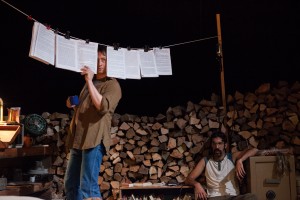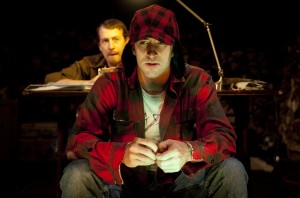What’s odd about Body: Anatomies of Being at the New Ohio Theatre, is that, as much as it wants to break the audience out of being shocked by nudity, the script doesn’t measure up. The dialogue goads the audience to be comfortable with the body and all of its functions, “Wake up. Fart. Pee. Blow nose while pooping. Burp. Yawn. Drink water. Burp. Cough. Blow nose. Pick at clogged hair follicle under right arm. Burp.” But seriously, to what end? When all the actors have plucked and trimmed their pubic hair to a landing strip, are you really that comfortable with the body? A number of challenges steer this production off purpose.
Fifty Shades of Activism
In Robert Lyons’ Death of the Liberal Class, directed by Jerry Heymann at the New Ohio Theatre, Nick, played with a self-deprecating aplomb by Steven Rattazzi, is a balding, pot-bellied academic who has written a book called "Robo Corp" that has garnered him great success after years of being an adjunct professor and a freelance journalist. However, after a “nervous breakdown” in which he rejects the ideas he has written about in the book—that robots will take over the world and that they are “standing on the precipice of the darkest period in history”—he has retreated to a farmhouse in Canada owned by his wife’s family.
His teenage daughter Andrea, played with a convincing mixture of indifference and righteousness by Jeanette Dilone, however, has dropped out of high school and followed him there. She has swallowed her father’s previous convictions hook, line and sinker, and has decided to pursue her own brand of activism, “hacktivism.” She is joined by the unassuming yet handsome Even, played by Justin Colon (who appears to have a magnificent singing voice revealed in one small snippet in the play) whom she has met online. The computer is the perfect tool for activism. Where it was once dangerous and possible to suffer bodily harm—think Kent State University in 1970 when four were killed and nine wounded in a melee between protesters and National Guard—computers have removed the physical component of activism and provided the safety of anonymity. Even and Andrea quietly, heads together, plan to take down the Robot Economy that her father has written about. The sexual tension is palpable even with their eyes glued to their respective keyboards.
Meanwhile, everyone is mad at Nick. He’s been sleeping with Maggie, the dewy skinned and wholesomely pretty Olivia Horton, who lives on the farm next door with her husband, and also with Daphne, his wife, when she comes to visit. Maggie’s husband beats her for sleeping with Nick and Daphne chides him for leaving New York City.
Although there is still sexual chemistry between them, Melissa Murray as Daphne captures the understated disdain that New Yorkers have for those who leave. After all, who, in their right mind, would leave an Upper West Side apartment in New York City? She may as well come out and say it: he’s a loser! But, somehow, living on the farm, in the middle of Canada has made Nick feel peaceful, and dare we say it, happy. In the opening scene, Nick’s daughter notes how happy he seems. When he retorts “I’m not allowed to be happy?,” she nearly chokes with disgust, “Not this happy!”
Nobody wants Nick to change, especially his daughter. Yet, he no longer believes in the chaotic world he wrote about in his book nor does he want to have anything to do with it. His daughter decides to carry out her own grassroots activism, and hacks into Maggie’s account. Comic relief comes unexpectedly in an exchange between Nick, his daughter, and Constable La Fontaine, a Canadian Mountie who works in the cyber division, played with wonderful restraint by the mustachioed Arthur Aulisi. When the Constable arrives at the farmhouse to investigate the hacking, they deny it. Although the Constable remains beautifully polite, it appears he knows better. It’s a moment filled with tension and irony.
Although we usually think of men as being better hackers, Andrea is actually the gifted hacker who plans to infect Wall Street computers with a virus that will bring them crashing down. Nick pleads with her, and asks her to see how it will affect the little people, but she is so full of her own—or rather Nick’s—ideological idealism that she runs off with Even to carry out the plan.
When Nick’s wife realizes he isn’t coming back to the city with her, she leaves and gives him an eviction notice from the farmhouse. In the beginning of the play, you wonder what Nick’s appeal is: he’s a middle-aged guy with thinning hair and a thickening middle who’s sleeping with two beautiful women. But then we see that it’s his underlying sensuality that makes him attractive. After he rejects his own lofty “liberal” ideas about the Robot Economy, he actually becomes more attuned to the world of living through the senses. At one point, his daughter comes to him, computer attached to her arm like an extra appendage, complaining she can’t get access. He gently says “access these trees… access the sky.”
Robert Lyons’ play asserts a very important message in this age of technology: that it can be both useful and destructive, but what it’s not, is sensual. Nick may be the underdog here, but in the end, he’s the one who is the true activist: being in tune with the senses is more likely to save humanity than anything else. The rest of the world around him needs a little more time to get there.
Death of the Liberal Class, written by Robert Lyons and directed by Jerry Heymann, runs through Feb. 13 at the New Ohio Theater (154 Christopher St., #1E between Greenwich and Washington Sts.) in Manhattan. Performances are Wednesday–Thursday at 7 p.m., Friday–Saturday at 8 p.m. and Sunday at 5 p.m. Tickets are $18 and can be purchased by calling 1-888-596-1027 or visiting http://www.NewOhioTheatre.org.
Fatalistic Fandoms
In the Ice Factory Festival’s run thus far, no play has managed to reconcile the New Ohio Theatre’s intimate space with the magnitude of its subject matter as well as George and Co.’s production of Holden. The wrathful claustrophobia that Holden emanates very quickly imbibes the audience itself, and we find ourselves shifting uncomfortably in our plush blue seats. But it doesn’t begin that way. We are lulled into enjoying the sarcastic dialogue, the self-aware movements of the actors and Billie Holiday’s sad voice, which croons occasionally as part of the play’s soundtrack. But this false security is made all the more frightening by the individual character revelations that slowly begin to transfigure and twist the production into an entirely unexpected and strangely arresting creature.
The set is an organic element of the story: its walls of chopped logs and floors of wood chips create a color scheme of unending amber brown. Typed-up sheets of paper hang from a clothes line. It is evidence that we are in a writer’s island. There is a spare cot, shelves stacked with books and a detective-like desk with a reading lamp, typewriter and magnifying glass. And everywhere, crumpled balls of paper litter the furniture and the floor. Holden already seems overly cramped in its setup, and we wonder how its actors will negotiate the space, but this is a calculated move on the part of scenic designer Nick Benacerraf.
Writer-director Anisa George notes that Holden exists “in an impossible time and place,” lending an otherworldly tint to the log bunker in which her story is set. Four figures lie sleeping in the darkness as crickets chirp drowsily outside. One man gets up, quietly turns on a reading lamp and opens up J.D. Salinger’s novel, The Catcher in the Rye. His name is Hinckley (Scott Sheppard) and he begins to retype the entire book, word for word, with a typewriter set in front of him until the tall, side-burned and bespectacled figure of Chapman (Jaime Maseda) stops him. Both Chapman and Hinckley are devotedly respectful to the pajama-clad, white-haired Jerry Salinger (Bill George), who wakes up from a war-torn nightmare (the real Salinger took part in the hellish storming of Normandy on D-Day), but Zev (Matteo Scammell) seems to be on equal terms with the author.
Zev, a serious young man in torn jean-shorts and a red flannel shirt is the "new guy," as Chapman and Hinckley derisively christen him. It is not until the closing stages of Holden that the two start calling him by his name. A little girl called Peggy (Adele Goldhader) is the only one who is able to enter and exit the bunker; she appears to be Salinger’s 10-year-old daughter, and keeps urging him to return to the rest of his family. But Salinger pays little attention to his environs, even completely disregarding his three bunkmates as he fusses and fumes with his writing.
As the play progresses, it becomes evident that Chapman and Hinckley are infamous men. The former is Mark Chapman, the man who killed John Lennon in 1980, and his compatriot is John Hinckley, Jr., the man who attempted to assassinate Ronald Reagan in 1981 (a sore point for him since he couldn’t "finish the job" as Chapman did). Both men were apparent lovers of The Catcher In the Rye, rationalizing their murderous intents with Holden Caulfield’s disdain for "phonies." Hinckley was famously obsessed with Jodie Foster’s character in the movie Taxi Driver, as George funnily references before she reveals the character’s true self, but still he and Chapman are scarily similar. When Jerry (in the play) writes down one sentence in a fit of inspiration and falls back asleep, his two fans are rendered speechless by his words: “In his mind, fulfillment meant loving a good woman and killing a bad man.”
George cleverly introduces her characters with relative anonymity. Maseda makes Chapman seem like a hyperactive publisher or agent, impatiently keen on the release date for Jerry’s new book. Sheppard renders Hinckley as a comically bumbling figure, interacting innocently with his environment. It is only Zev, played to ominous ferocity by a supremely talented Scammell, who remains unknown to us until the end. Why is he being held in this purgatory-like fan land with such company as Lennon’s killer and Foster’s stalker? He doesn’t even like Salinger, and thinks Holden is “kind of a loser” to the utter shock of his fellow bunkmates. We soon find that George has created an even more terrifying character in Zev, one especially menacing to the modern American. He is the nameless, unselective kind of killer who rejoices in the power of guns and in closed, packed places. Even Chapman and Hinckley are disgusted by him, and it is with a bloodcurdling, knowing shiver that we hear Zev’s words: “I don’t like people. I like maps...blue prints. I like to see where the entrances and exits are. Public places. Stadiums. Schools. Theaters.”
The audience is flooded with memories from the country’s collective consciousness: Sandy Hook Elementary, a movie theater in Aurora, Colorado, and a church in Charleston, South Carolina. We see the second generation of American violence in Zev, and it is an aimless, indiscriminate violence borne not out of emotion, but detached cruelty. Zev’s fight isn’t against "the phonies" like Chapman and Hinckley. His violence doesn’t require reason or impetus, but merely opportunity. This complete shift in tone and performance that quietly occurs halfway through the play is an unflagging testament to George’s intelligent directorship and riveting dialogue. Holden merits a visit, and it almost seems like a citizen’s requirement, as we remain mired in the sorrows of modern violence.
Holden ran from August 6-8 at the New Ohio Theatre (154 Christopher St., #1E between Greenwich and Washington Sts.) in Manhattan. For more information, visit www.newohiotheatre.org.
A Rave Gone Wrong
When the ancient Greek playwright and epic raconteur Euripides described the bacchanalian excess of the Maenads, Dionysus’ virginal followers, he leaves no doubt that it is an intoxicating affair: “With milk and wine and streams of luscious honey flows the earth, and Syrian incense smokes…” Karaoke Bacchae, Meta-Phys Ed.’s subversive production of the ancient Greek play, The Bacchae, at the New Ohio Theatre, takes intoxication to another dimension
Losing the Plot
Of the three plays open to critics at the Ice Factory Festival this summer, Losing Tom Pecinka, staged at the New Ohio Theatre by Morgan Gould & Friends, is most given to playfulness. Even with the story’s grey backdrop of Tom's death (an immediately evident plot point), writer and director Morgan Gould is more intent on good-humored self-mockery. But even with the occasional laugh that this meta-humor elicits, Losing Tom Pecinka struggles to elevate its story, and regularly defuses its own comedic fireworks.
The story surrounds the event of the eponymous character’s passing, and the destructive attempts of his friends in coping with it. The character Tom Pecinka (whose ghost and flashback-version is played by Zack Segel) is named after a real-life founder of Morgan Gould & Friends, and we assume that the title is a play on the actual Pecinka’s move to the Yale School of Drama. Janice (Tommy Heleringer, pretty in a dress) is a guilt-ridden ex-girlfriend, constantly at odds with Kai (Christopher Geary), Tom’s bitter best friend. Ryan Pecinka (Amir Wachterman), brother of the deceased and funniest of the lot, suffers silently in his love for Janice.
Wachterman is the undeniable talent of the show, straining laughter from even the most confused situations. His fairly ingenious dress-up as a sweaty tennis player, complete with a white sweater tied around his shoulders, making love-stricken speeches to Heleringer’s Janice makes for an uproarious incongruity. Heleringer himself is a shrill delight, making do with Janice’s oftentimes puzzling situational comedy to great effect. The entire cast bubbles with an underlying humorous energy, but their fractured dialogue and the intractable intent of Gould to exercise her didacticism, crowd out any real comedy. The plot is threadlike at best; Gould focuses more on unveiling her satiric takes on comedic tropes and stereotypes she has found in theater.
Indeed, the point Gould tries to make is that theater, and entertainment in general, has fallen into dreary, acceptable routines. These are routines from which her audiences need to be jolted out of; hence her lackadaisical attitude towards public relations (as evidenced by the production's promo). But the primary fault of Losing Tom Pecinka resides in its stubborn insistence on such satire. A heated discussion between Ryan and Janice, which held some potential for good drama, devolved into a satirical scientific run-on, the kind Christopher Nolan or Steven Spielberg would be proud of.
Even these scenes struggle to take off. We are left wondering whether the ghostly Tom that appears to Kai after his death is a comedic poke at depictions of the afterlife in traditional theater (perhaps Hamlet’s ghost?) or a product of Kai’s dramatic, psychological breakdown. It is only at the very end of Losing Tom Pecinka that we finally understand Gould’s directorial intent. Since the plot is a bare canvas, only present to hold the entire production together, the ending loses its finality and importance. Even after a seeming resolution to the play (all the characters huddle around Tom's grave in nostalgic remembrance), they all abruptly break into song, in an ineffable attempt at satirizing the musical.
There are moments of real hilarity, however. The ending is a particular delight to watch, since we are now certain that they’ve been making fun of our seriousness all along. Pregnant pauses and audience interactions with the cast produce considerable audience laughter, especially towards the end. Abrupt changes in time and place heftily undercut the sometimes-awkward interactions between actors, and keep us curiously waiting for the next scene. The sexual tension between Heleringer’s Janice and Wachterman’s Pecinka is palpable, but never serious. Even the eponymous character’s death is rendered comical, somehow. Yet, a willful need to jerk its audience out of its seated stupor and be “not boring” makes Losing Tom Pecinka a parody of itself: to be new and exciting might not be so interesting after all.
Losing Tom Pecinka ran from July 8-11 at the New Ohio Theatre (154 Christopher St., #1E) in Manhattan. For more information, visit http://www.NewOhioTheatre.org.












